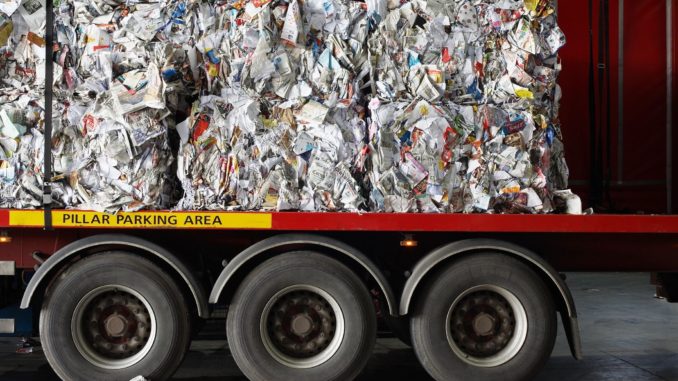
By Isabel Yanes
If there’s one thing I’ve learned this year, it’s that there is no such thing as “away.”
When we throw something “away” it goes somewhere: to a landfill, a recycling facility, our waterways, or even the ocean. Landfills alone produce greenhouse gases that worsen our climate-change problem. Although these are known facts, many people don’t question the waste management system in place. Moreover, most don’t consider the impact our waste culture has on the environment and future generations.
But why would they? People are busy and they like their convenience.
As post-production workers, we need to realize that the issue of waste and its impact on the environment cuts close to home. Look at our workspaces: Local 700 members often work on shows where lunch is paid for or coordinated to be ordered out. Many of us sit at our desk and eat alone because of our intense work schedules, and in the process, single-use containers and utensils are used once and promptly thrown away.
Until I took the Waste Warrior course offered at the Burbank Recycling Center, I never considered how my actions, the waste culture of our society and its work environments, and, more important, the irresponsibility of manufacturers, impact the world.
Now I know this may come across as tree-hugging-hippie-talk, but stay with me here y’all! I’m not here to blame individuals for littering, like the Keep America Beautiful campaign did, or to make you feel like a terrible human being because you go to Starbucks for your morning coffee. I hope to inspire you to demand change in our society and your workplace by understanding some of the waste problems we’re facing, and why we’re in this mess to begin with.

Our society has adopted a system called the materials economy, which goes “from extraction, to production, to distribution, to consumption, to disposal.”1 It is a linear system fueled by consumers buying goods, disposing of them quickly, then continuing to buy more goods. Although it drives our economy, this linear system is terrible for the environment. Limited natural resources, such as forests, are being harvested faster than they can be replenished to create goods that we dispose of relatively quickly. The production and distribution stages have inefficiencies and negative environmental effects as well, such as greenhouse gas emissions.
I want to focus on consumption and disposal. If you want a deeper look at this system, I highly recommend checking out Annie Leonard’s movie short (and later book) “The Story of Stuff.”
With this linear system in mind, it should be no surprise to learn that the disposal stage is running into limitations as the manufacturing of products like plastic and single-use items has increased. Why has it increased? Companies have capitalized on our love for convenience and the low price tag of plastic. Restaurants provide to-go containers, grocery stores provide produce bags, pre-packaged food, and household products, while online marketplaces provide same-day pick-up and delivery of pre-packaged products.
I’ll be the first to admit that these conveniences are impressive, but what happens to all the waste it creates? And who is responsible for it?
Our current legal and political framework doesn’t hold manufacturers accountable, so the blame has shifted onto consumers. We’re the reason the Great Pacific Garbage Patch exists… right? Well, no, absolutely not. We’ve been coerced into using this linear system instead of a closed-loop, circular system “in which waste from one process is the raw material for another.” In other words, we don’t have a way to reuse the waste we’ve created, so a lot of it ends up polluting our land and oceans.
But wait, what about recycling? Well, I found out early on in my program that there are some dirty truths about recycling.
First off, recycling is driven by a market where businesses buy recycled materials to be used in manufacturing. This system means a market determines which recyclables have value and which aren’t worth the energy and labor cost it takes to recycle them. Some recyclables, such as plastic, are not as strong as their raw material counterparts and do not have a 1:1 input/output ratio, so it can be more expensive to recycle than to harvest raw materials. Organizations and government subsidies are sometimes used to promote certain types of recycling, such as carton recycling. While this is a great start, many manufactures don’t use recycled materials in their products.
There are some companies that tend to use buzz words such as ‘recycled content’ to attract consumers, but in reality, a closer look at their packaging reveals that it is not true in its entirety. This could be a cause of concern. To know what is the difference between primary and secondary packaging is of utmost importance. The products chosen by them as ‘recyclable’ packaging materials should be what it says! And as mentioned, it is not so in most cases!
Greenwashing, anyone?
Recycled? Maybe Not
Similarly, many products have recycling symbols on them, but that doesn’t mean they are being recycled. Did you know that only 9 percent of plastic has ever been recycled? In the 1990s, we switched to single-stream recycling bins with the hope that more convenience would bring forth more recycling. While it can be said that the rates of recycling increased, residual rates also increased. Residuals refer to “the stuff that shouldn’t have been put in the bin and the stuff that could have been recycled” but wasn’t because the recycling facility was unable to sort it due to contamination. So even if recyclables make it to the blue bin, many are no longer valuable because contamination of non-recyclables is too high.
Contamination can occur in many forms: (1) Plastic bags that junk up recycling machines, (2) food waste and food-soiled containers, (3) loose shredded paper, brightly colored paper and wet paper, (4) hazardous and biohazardous waste, (5) mixed-material packaging and (6) other recyclables not accepted at your local recycling facility. Many people will use a skip bin hire sydney has to offer to take these away if the amount is bulky enough, and while many good companies ethically process their waste this is still something to consider.
A great example of mixed-material packaging is Tetra Paks, which have combined layers of paper, aluminum foil, and plastic that are very difficult to separate and therefore not accepted by many recycling facilities.
Some facilities also limit which plastics they’ll accept (containers often have a number ranging from 1-7 printed on them; that’s a code that helps recycling centers sort plastic). The Burbank Recycling Center, for example, only accepts plastics numbered 1, 2 and 5, and guess what? Those plastic clamshell containers that your blueberries come in probably won’t be recycled even though they say #1 PET. Technically they are a plastic called #1 PET thermoform, which “must be heated at a different temperature and… must be recycled separately.” And to add insult to injury, if those clamshells have stickers on them, then they are considered contaminated because of the mixed materials, and therefore they are sent to the landfill.
The materials that pass this initial screening are sent to recycling processors, but here’s where we’ve hit yet another limit. China “handled nearly half of the world’s recyclable waste for the past quarter century,” but in January 2018, “China’s National Sword policy… banned the import of most plastics and other materials headed for the nation’s recycling processors.” This policy also implemented strict contamination standards of 0.5% or less starting in March 2018.7
As a result, municipal recycling programs in the U.S. had to cut costs by reducing accepted recyclable materials, sending materials to landfills and incinerators, and even stopping recycling programs all together. Although recycling outreach programs are being implemented to educate residents, this is a solution too far downstream and again blames the consumers instead of the manufacturers for the lack of waste planning and management of products after consumption. Recycling can be a part of the solution, but it is not the solution to our waste issue.
‘There are some dirty truths about recycling.’
When it comes to our industry, I won’t get into the waste created on production sets because I get headaches just thinking about it. But, as I said, post production offices are big culprits of waste when it comes to meals and everyday office materials.
As an assistant editor in scripted television, I’ve worked on shows that pay for lunch, and as convenient as that is, the resulting number of single-use items is astonishing. If I were to order a salad for lunch everyday for the duration of a show (we’ll say 5 months = ~110 days), I would go through 110 salad containers, 110 dressing containers, 110 forks and 110 napkins. The scary part is that not every meal is as minimal in its single-use items as a salad, plus every pick-up comes with a bag. When you multiply this by a post team of 10+ people, the number of single-use items easily flies past the thousand mark.
If more restaurants had take-back programs for their containers – like Soup Goddess, which gives you credit on your next purchase when you bring back their Mason jar container – we could significantly reduce the every day waste created by to-go meals. Better yet, imagine a world where our members used lunch as a way to come together as a crew and eat together on breaks at a restaurant or the commisarry on studio lots. Alternatively, it could also be helpful to consider catering companies that can provide lunch to office spaces. This may also help to decrease the use of single-use plastic. Searching for corporate catering near me on the internet can allow one to find the right food service for their workplace. Not only would we reduce the number of single-use items wasted, we would get to know each other. Along the way, we might also give a boost to the MPEG Outreach Committee’s “Lunch is Not a Luxury” campaign, which is designed to bring awareness to the importance of mealtimes in establishing a healthful workforce (and to remind employers of their contractual obligations).
In order to help out on our end as consumers, I’ve come up with some examples to reduce waste in the office:
- Bring lunch to work in reusable containers if lunch is not provided or go to a restaurant/studio commissary in person. Bonus points if your team goes together.
- Use reusable dishware and community condiments to avoid individually packaged items from restaurants.
- Encourage buffet catered lunch from local businesses who use reusable catering ware instead of one-time use containers. It’s usually cheaper per person than individual lunch orders. Don’t forget to use office dishware.
- Order from restaurants that have take-back programs or compostable to-go containers that can go in your office compost bin (see below), but make sure to rinse them out if they have meat or dairy food scraps still inside.
- Consider getting an office compost bin for food scraps (no meat or dairy) that can be dropped off at an LACompost location. If you have a freezer, store your compost there so there’s no smell and the organics can decompose even faster once composted.
- Ask your post PA to use reusable bags for crafty and lunch runs.
- Reuse food containers like the “chocolate-covered almond” box. Your PA can fill reusable bulk bags in the store’s bulk section instead of buying a new box and save money too.
- Create a “scratch paper” box that encourages people to use the blank side of paper to write notes. Provide producers with this paper on clipboards for screening notes.
- Use real towels and reusable napkins instead of paper towels in the kitchen and bathroom.
- When recycling, check with your local recycling facility for their acceptable items. Make sure to rinse everything out completely so there is no food contamination.
While this list is a good start, having a quick meeting the first week editorial starts can greatly impact the success of your efforts. Explain why this is important and discuss what else the team thinks they can do to minimize waste. When ideas come from the group and not just one person, it’s much easier to change habits.
Implementing small changes like this can impact our waste culture in a big way, showing manufacturers and our legislators that we don’t want all this extra waste or the environmental effects they cause. I encourage everyone to actively think about the waste they create both at the office and at home, and see how you can reduce your waste.
Remember: Reduce, Reuse, then Recycle!
Isabel Yanes, a resident of Burbank, is an Assistant Editor who joined the Guild in 2018.





